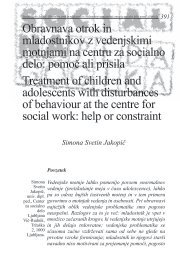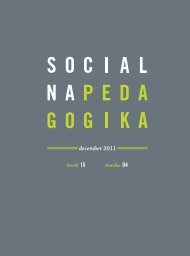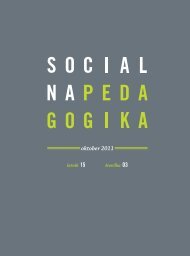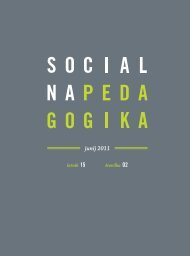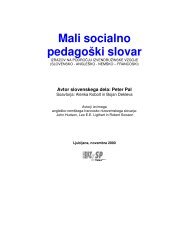št. 1 - Revija Socialna pedagogika - ZZSP
št. 1 - Revija Socialna pedagogika - ZZSP
št. 1 - Revija Socialna pedagogika - ZZSP
Create successful ePaper yourself
Turn your PDF publications into a flip-book with our unique Google optimized e-Paper software.
<strong>Socialna</strong> <strong>pedagogika</strong>: 2011 vol. 15, <strong>št</strong>evilka 1<br />
pričakovanja pri želeni razredni klimi. Pomembna povezanost obstoječe<br />
razredne klime s samopodobo dijakov in dijakinj se je pokazala zgolj pri<br />
družinski samopodobi.<br />
Ključne besede: obstoječa razredna klima, želena razredna klima, samopodoba,<br />
dijaki Gimnazije Kranj.<br />
Abstract<br />
The classroom atmosphere is defined as every event in the classroom<br />
determined by interpersonal relations, the personal development of<br />
students and the systemic characteristics of the class. It is an important<br />
starting point for teachers’ efforts. Classroom climate is connected with<br />
students’ scholarly achievements, cognitive development, motivation and<br />
their self-image (Maxwell & Chmielewski, 2008; Roskam & Nils, 2007).<br />
Our survey focuses on how first and second year students of the grammar<br />
school in Kranj perceive the existent and the desired classroom climate,<br />
the differences between male and female students in their evaluation of<br />
the existent and the desired climate, and the possible relation between<br />
students’ self-image and the classroom climate. 197 students took part in<br />
the survey, filling out two questionnaires: a Classroom climate – students<br />
questionnaire (Zabukovec, 1998) and a self-image questionnaire (SPA)<br />
(Pečjak & Krajnc, 1998). We assumed that first year students would evaluate<br />
the existent classroom climate higher than second year students, and that<br />
female students would give a higher estimate of the existent classroom<br />
climate than male students. We also expected to ascertain a positive<br />
relation between students’ self-image and the existent classroom climate.<br />
The results undermined our hypotheses. Second year students evaluated<br />
the existent climate higher than first grade pupils and there were no<br />
distinctions between male and female students in their evaluation. Female<br />
students do, however, have much higher expectations with regard to the<br />
desired classroom climate. The connection between self-image and the<br />
classroom climate was evident only in the students’ images of their families.<br />
Key words: existent classroom climate, desired classroom climate, self-image,<br />
students of the grammar school in Kranj.<br />
56





